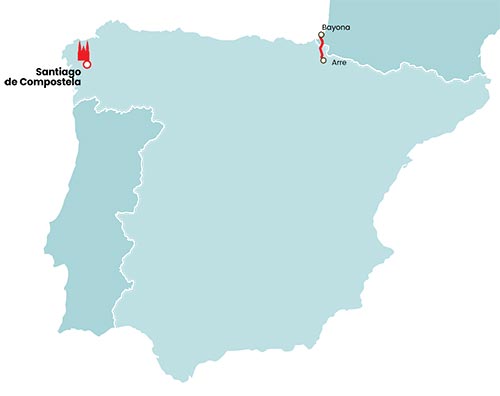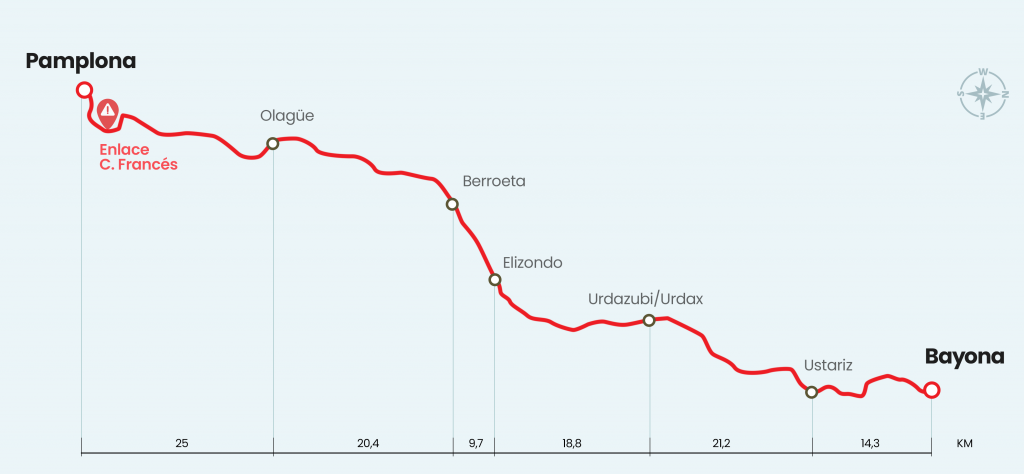Article translated by an automatic translation system. Press here for further information.

Baztan Way
6
109,4

The Association of Friends of the Camino de Santiago in Urdax-Baztán began in 2000 to recover this Jacobean itinerary that converges with the French Way at the gates of Pamplona.
A well-documented itinerary
The Jacobean Pilgrimage Road: Bayona-Urdax-Velate-Pamplona, published in 1964 by Padre Germán de Pamplona, has been the compass that has guided the Association in the work of recovering and valuing this Jacobean itinerary, working since its foundation in harmony with the French Association of the Atlantic Pyrenees. References to the Camino de Santiago Baztanés are evident. Father Germán stated in his research work, supported by documents of the time, that ?the Bayona-Velate-Pamplona route was much more transited than some think of as street vendors, pilgrims, merchants, kings and armies throughout the Middle Ages?. They used the main route that Bayona communicated with Pamplona. Another author such as María Teresa López de Guereño quotes that "the location of the premonstratense monastery in San Salvador de Urdax is not casual because it was its hospital purpose and care for pilgrims that originated it?. Also the historian José María Jimeno Jurío, in Los Caminos de Santiago through Navarra, points out that the Baztán Valley and the Ultzama were also pilgrimage itineraries towards Santiago and Finisterre.
Great rehabilitation and signalling work
The Baztan Way runs for 32 kilometers the department of the Atlantic Pyrenees, in the French region of Aquitaine, visiting the towns of Ustaritz, Espelette (one kilometer outside the route but with pilgrim hostel), Souraïde and Ainhoa. It then enters Spain through the Dantxarinea district and crosses Navarre along 77 kilometers, touring the municipalities of Urdazubi/Urdax, the Baztán Valley and part of the Ultzama, Lantz and the Odieta Valleys, Olaibar and Ezkabarte. In the French country, the Association of Atlantic Pyrenees of Friends uses a more discreet but sufficient sign. The handicap is that more attention must be paid to the Camino in order not to be lost. Already in Navarre, the Association in Urdax-Baztán, in addition to signaling with the typical yellow arrows, has counted during these years with the selfless collaboration of the artisans Genaro Fagoaga and Cesáreo Soulé, who have carved different Jacobean motives in stone in order to signalize and adorn the route. There has also been a great success in drawing the route, which avoids road traffic and reminds of another Jacobean path such as the Primitive.
Added to these tasks are the most laborious of road development and maintenance, recovery of old roads, restoration of bridges and hermites and other heritage attached to the route.
Hostels
The hostel network of this route is currently enough to be able to do it from hostel to hostel, having one at each stage end. Although in high season it may be somewhat scarce, gradually more private hostels are being opened at the rate that the influx of pilgrims does to this spectacular road. In the Frances section alone there are seven "hostels", plus all the offer there is in a town as touristic as Bayonne and another seven hostels throughout the Navarro section.
As we said earlier enough offer to "call" the pilgrim to go this way, but eye in summer that may be scarce depending on what day, therefore it is recommended to call in advance to not take surprises.